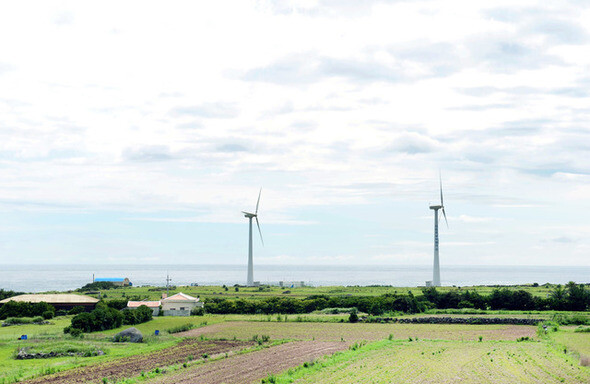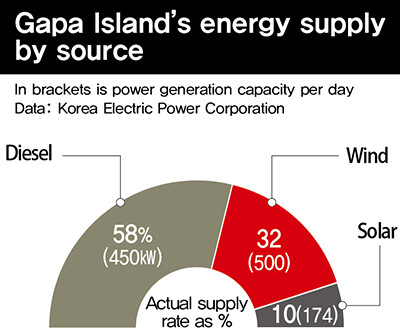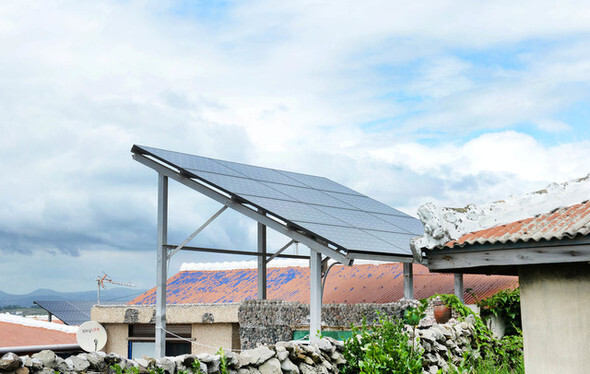hankyoreh
Links to other country sites 다른 나라 사이트 링크
One small island’s dream of energy self-sufficiency

At 0.85 square kilometers, Gapa Island is less than one-third the size of the Yeouido, an island in the middle of Seoul (2.94 square kilometers). Gapa is located between Mara Island, the southernmost point of South Korean territory, and Moseul Port on Jeju Island. But this tiny island is undertaking a revolutionary experiment in energy independence.
The project to bring energy self-sufficiency to Gapa Island was launched in 2011. The reason that the island was selected for the trial project is because of its small size, its plentiful wind power and solar energy and its proximity to Jeju Island.

A total of 14.3 billion won (US$12.49 million) was invested in the project. Two 250kW wind turbines were installed, along with 174kW solar panels in 49 locations. Other installations included an energy storage device, a system control center, power conversion equipment and remotely controlled power meters. The electricity produced in this way powers the households on the island, four electric cars and a desalination plant.
Since the energy self-sufficiency project began, the lives of island residents have changed dramatically. The population of the island is 178 people in 97 households, and solar panels were installed in the 49 households that are not composed of elderly people (65 years old and older).
Before the project began, electricity cost between 120,000 and 130,000 per month during the summer, but now, the price has fallen to one fifth of that, between 20,000 and 25,000 won. There has also been a major boost in the number of tourists, which rose from 10,000 in 2008 and 40,000 in 2011 to 110,000 in 2015.
“At first, we weren’t satisfied with the results of renewable energy. Now, though, it’s benefiting us in two ways: our electricity bills are lower and the number of tourists is higher,” said Jin Myeong-hwan, the 55-year-old mayor of Gapa Island.

Between Apr. 23 and July 12 of this year, Gapa Island had a cumulative energy self-sufficiency rate of 42%. The island is meeting 32% of its energy needs from wind power and 10% from solar power. The rate climbed above 50% in May, but fell again in the monsoon season. The other 58% of energy is still supplied by diesel generators.
The combined generative capacity of wind power and solar power is 674kW a day, which is already much higher than the island’s average daily energy need of 142kW and its maximum need of 230kW. The problem, however, is that the supply of wind power and solar power is not stable. For this reason, surplus power is stored in the 3.86MWh energy storage system, but this can only be used for up to eight hours.

As the energy self-sufficiency rate of 42% shows, Gapa Island is less than halfway to its goal. It will have to raise the rate to 100% to attain true energy self-sufficiency.
“If we doubled the capacity of the current energy storage system, we could supply energy for up to three days and raise the self-sufficiency level to 100%. But to do that the current price of energy storage needs to drop by half,” said Hwang U-hyeon, head of the new industry team for the Korea Electric Power Corporation (KEPCO).
The energy self-sufficiency project that began on Gapa Island is already spreading to other islands. The second project, on Gasa Island in Jindo County, South Jeolla Province, aims to reach 100% energy self-sufficiency by increasing the capacity of renewable energy generation. The third project, on Ulleung Island, is experimenting with energy self-sufficiency for a much larger population (about 10,000) than Gapa or Gasa Islands.
The South Korean government is currently asking companies to invest in the energy self-sufficiency project on five islands, including Deokjeok Island.
The government and Jeju Island are planning to help the whole of Jeju Island – with a population of 600,000 people – reach carbon-free energy self-sufficiency by 2030.
Renewable energy generators with a capacity of 180MW have already been built around Gujwa Township as part of a project costing 350 billion won.
“If we’re successful on Jeju Island, we’re planning to gradually extend that success to cities on the mainland. Electric cars, solar panels for homes and energy storage will lead the way to change,” Hwang said.
By Kim Kyu-won, staff reporter
Please direct questions or comments to [english@hani.co.kr]

Editorial・opinion
![[Column] Park Geun-hye déjà vu in Yoon Suk-yeol [Column] Park Geun-hye déjà vu in Yoon Suk-yeol](https://flexible.img.hani.co.kr/flexible/normal/500/300/imgdb/original/2024/0424/651713945113788.jpg) [Column] Park Geun-hye déjà vu in Yoon Suk-yeol
[Column] Park Geun-hye déjà vu in Yoon Suk-yeol![[Editorial] New weight of N. Korea’s nuclear threats makes dialogue all the more urgent [Editorial] New weight of N. Korea’s nuclear threats makes dialogue all the more urgent](https://flexible.img.hani.co.kr/flexible/normal/500/300/imgdb/original/2024/0424/7317139454662664.jpg) [Editorial] New weight of N. Korea’s nuclear threats makes dialogue all the more urgent
[Editorial] New weight of N. Korea’s nuclear threats makes dialogue all the more urgent- [Guest essay] The real reason Korea’s new right wants to dub Rhee a founding father
- [Column] ‘Choson’: Is it time we start referring to N. Korea in its own terms?
- [Editorial] Japan’s rewriting of history with Korea has gone too far
- [Column] The president’s questionable capacity for dialogue
- [Column] Are chaebol firms just pizza pies for families to divvy up as they please?
- [Column] Has Korea, too, crossed the Rubicon on China?
- [Correspondent’s column] In Japan’s alliance with US, echoes of its past alliances with UK
- [Editorial] Does Yoon think the Korean public is wrong?
Most viewed articles
- 1‘We must say no’: Seoul defense chief on Korean, USFK involvement in hypothetical Taiwan crisis
- 2N. Korean delegation’s trip to Iran shows how Pyongyang is leveraging ties with Moscow
- 3Amnesty notes ‘erosion’ of freedom of expression in Korea in annual human rights report
- 4‘Weddingflation’ breaks the bank for Korean couples-to-be
- 5[Reportage] On US campuses, student risk arrest as they call for divestment from Israel
- 6[Column] Park Geun-hye déjà vu in Yoon Suk-yeol
- 7Korea sees more deaths than births for 52nd consecutive month in February
- 8[Editorial] New weight of N. Korea’s nuclear threats makes dialogue all the more urgent
- 9Will NewJeans end up collateral damage in internal feud at K-pop juggernaut Hybe?
- 10[Guest essay] The real reason Korea’s new right wants to dub Rhee a founding father